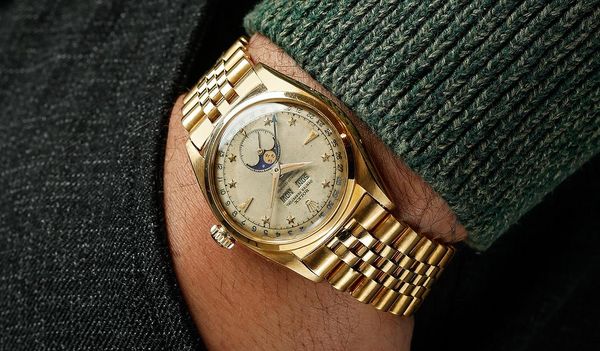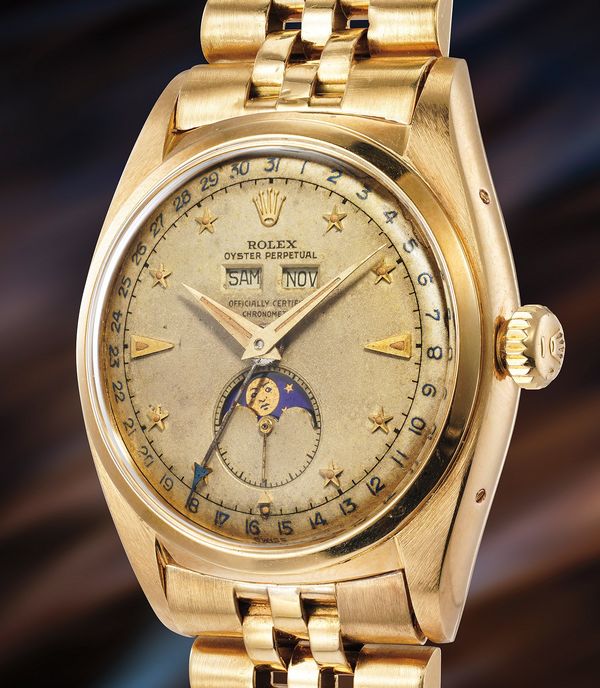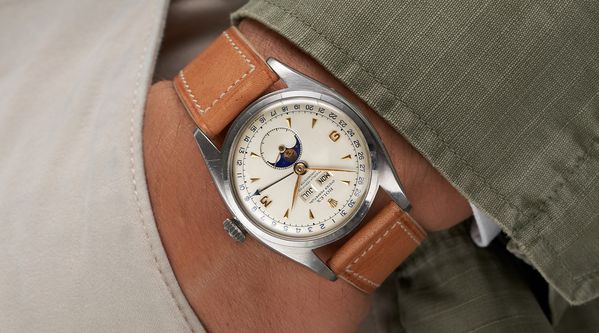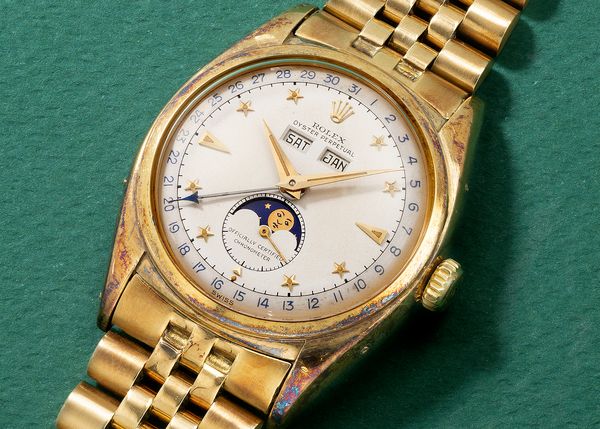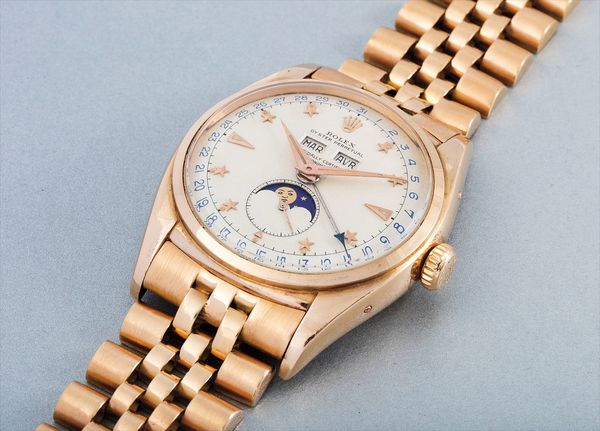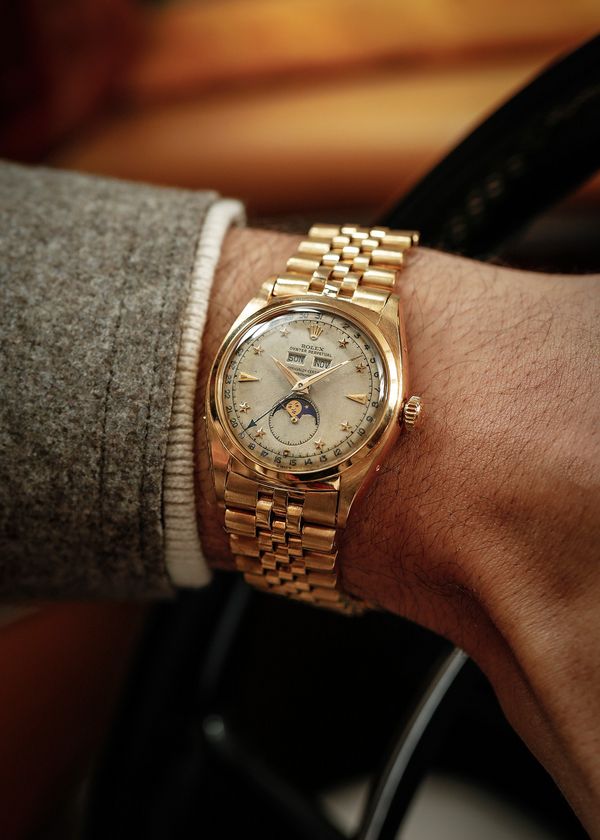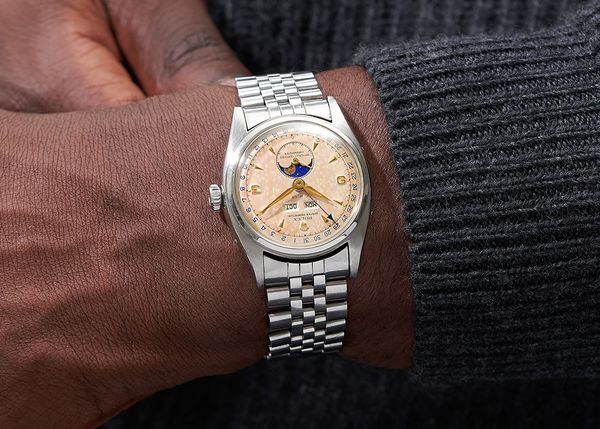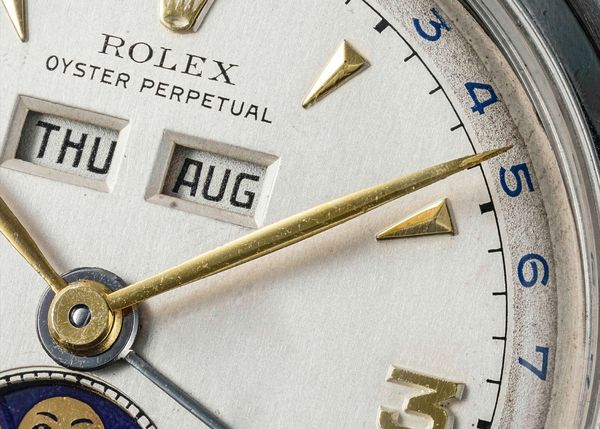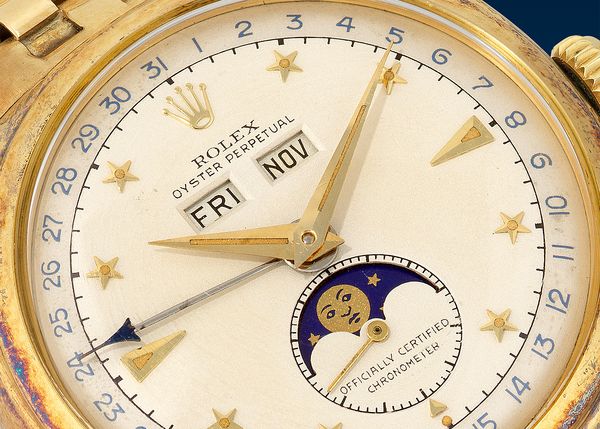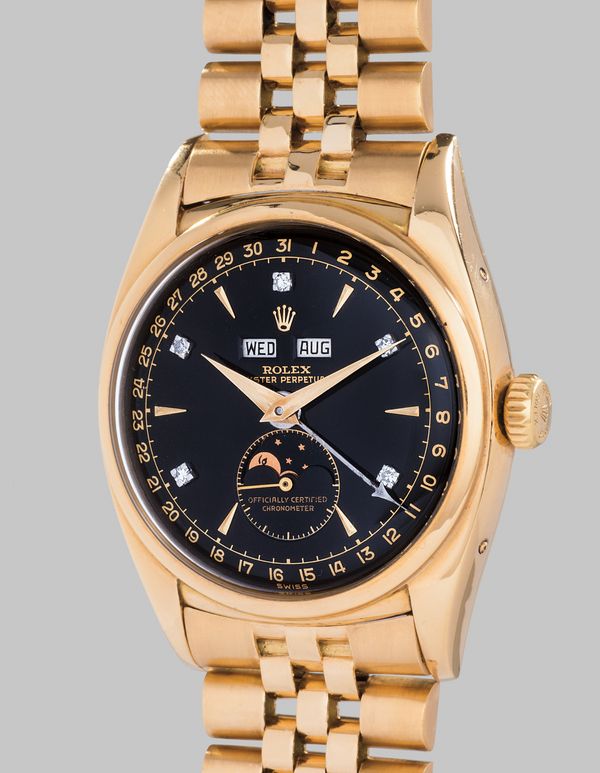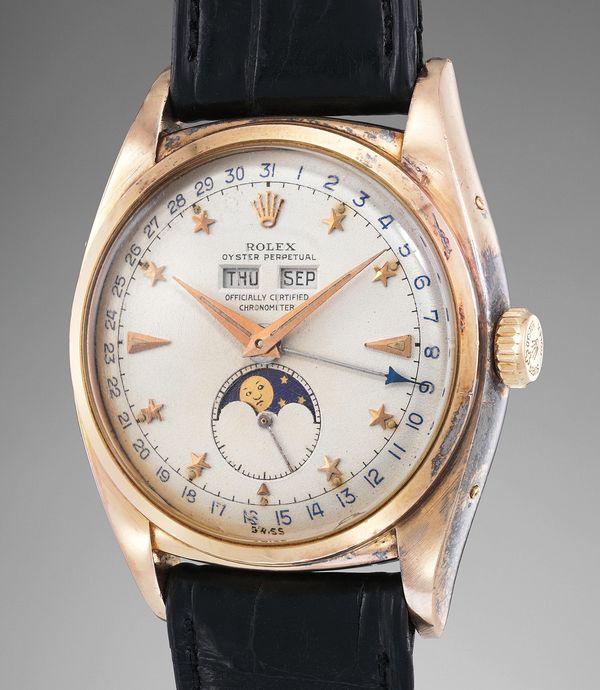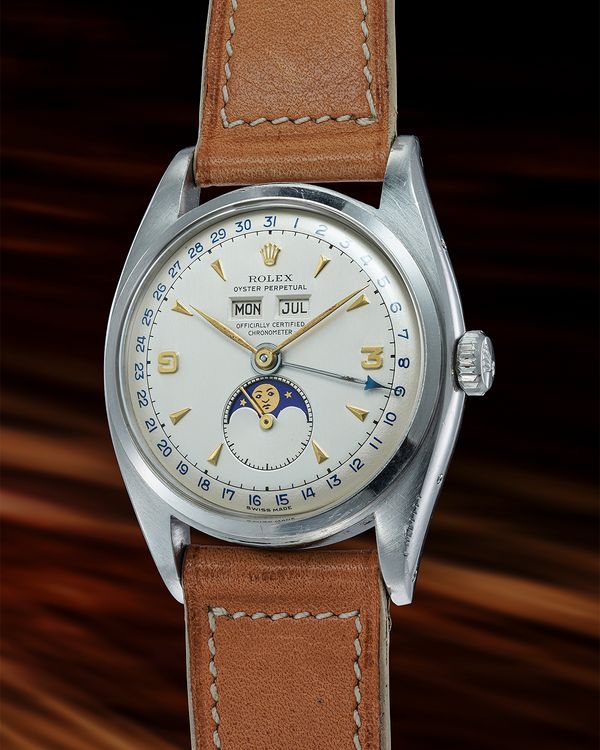Our first live auction of 2024, the PHILLIPS Geneva Watch Auction: XIX, takes place on May 11 and 12, at the Hotel President, at Quai Wilson 47 in central Geneva. The auction includes more than 215 of the world's finest watches – and though we are loath to boast, we truly think it's one of the best catalogs we've ever put together. We'll be highlighting a number of the most interesting lots and stories featured in the sale over the next month, including the beautiful circa 1951 Rolex ref. 6062 "Stelline" in yellow gold featured in this article.
– Logan Baker
Rolex built its identity around the production and marketing of high-quality wristwatches that consummately threaded the needle between sporty and elegant designs. The Submariner, Daytona, Day-Date, Datejust, Explorer, GMT-Master, Air-King, and Oyster Perpetual are all historic Rolex collections that focused on simplicity, reliability, and legibility above all else.
Rolex has rarely experimented with the world of high complications. Save the Daytona and GMT-Master, Rolex seldomly incorporated anything other than a date window in its watches throughout the 20th century. There was a brief moment in time, however, where that wasn’t entirely true. Rolex experimented with the realm of complicated calendars right in the middle of the last century, introducing a pair of triple calendar watches with moon-phase displays in successive years.
The ref. 8171 came first, in approximately 1949, using a non-Oyster case, followed by the ref. 6062, in approximately 1950, with a water-resistant Oyster case. Both watches featured largely identical dial configurations and the same self-winding caliber inside. The ref. 8171 and ref. 6062 are the two most complicated vintage Rolex watches powered by an in-house Rolex movement.
The ref. 8171 is an oddball that continues to captivate collectors to this day, but it’s the ref. 6062 that has ascended to grail status in much of the enthusiast community. After all, the beautiful black-dial ref. 6062 owned by the Bao Dai, the former Emperor of Vietnam, has held the title of the most expensive Rolex watch sold at auction twice in its history (sold by Aurel Bacs and Phillips both times). Other rare and well-known examples include a pink-gold example once owned by Gordon Bethune, the former CEO of Continental Airlines, and the so-called “Dark Star” (also known as “The Sock”).
All three of these ref. 6062 examples have come up for auction in recent years and enthralled collectors around the world for their unexpected beauty and unusual status as a Rolex watch. As part of the upcoming Geneva Watch Auction: XIX, Phillips sourced an extremely rare Rolex ref. 6062 "Stelline" in yellow gold that stands tall as one of the finest examples to ever appear at auction. We estimate the watch, lot 214, to sell for between 120,000 and 240,000 Swiss francs.
We’ve put together this collectors’ guide to the history of the ref. 6062 to help you understand just what makes the ref. 6062 series so special.
Understanding The Ref. 6062
The ref. 6062 was an outlier in Rolex’s catalog in 1950, the year it debuted. A precious metal triple calendar with moon-phase clearly stood out among the stainless-steel, three-handed Air-Kings, Datejusts, and Bubblebacks that made up much of Rolex’s offerings in the late 1940s and early ‘50s.
It could rightfully be considered an early foray into the luxury market for Rolex. Were post-War consumers ready to embrace the expensive and elegant? Rolex created the ref. 6062 and ref. 8171 to find out.
What they learned was that the watch-buying public wasn’t quite prepared for a truly high-end Rolex; production of both references ceased by 1953. It would take more than 60 years before Rolex embraced the moon-phase complication again, with the recently discontinued Cellini Moonphase, introduced in 2017. Rolex was experimenting in all sorts of ways during those early days – interestingly, the ref. 6062 was even marketed as the “Cosmograph” in a series of early 1950s print advertisements, years before the Daytona would eventually adopt the term.
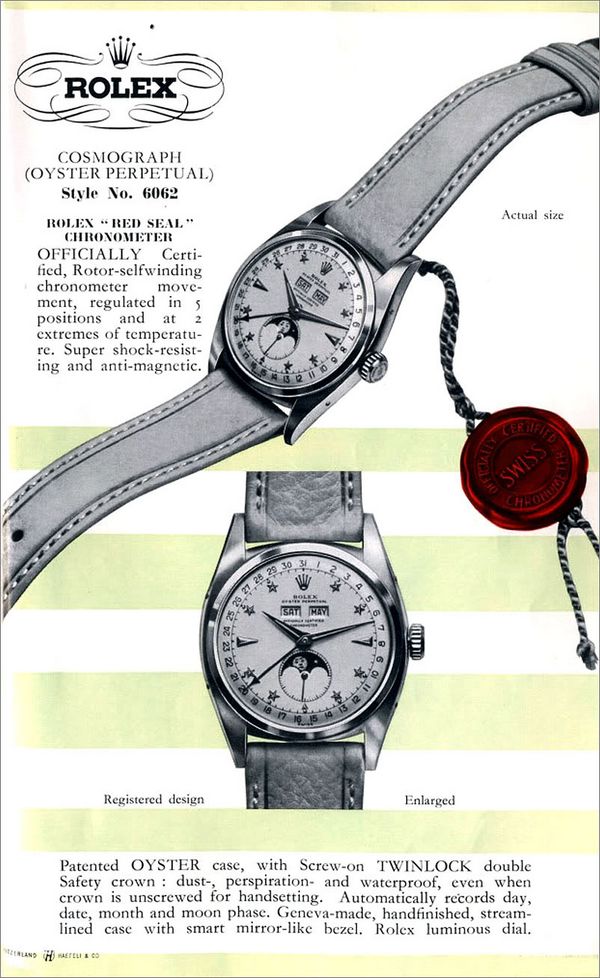
The release of the simpler Day-Date model in 1956 effectively replaced the ref. 6062 and ref. 8171 in Rolex’s catalog, ditching the month display and moon-phase to eventually become Rolex’s most recognizable design.
The ref. 6062 was a triple calendar, meaning it displayed the date (via a central pointer hand and date ring on the periphery of the dial) in combination with the day-of-week and month (indicated via twin in-line apertures above the dial’s center). A bosom-style moon-phase display was then incorporated into the small seconds at six o’clock, complete with a touch of whimsy: the face of the man-in-the-moon on the lunar scale.
The movement inside the ref. 6062 carried over from the 8171. It’s the self-winding, chronometer-certified caliber said to be an early in-house creation from the House of Wilsdorf, a notable evolution from the Valjoux ébauche found inside Rolex's earlier “Killy” Dato-compax series of triple-calendar chronographs.
The key difference between the 6062 and 8171, in fact, was the case designs.
The 8171 used a more classical, round 38mm case with a snap-on caseback and noticeably sharp lugs, a profile that earned it the famous “Padellone” nickname from collectors. The 6062, meanwhile, came outfitted with Rolex’s proprietary Oyster case design with a screw-down caseback offering enhanced resistance to water ingress. The ref. 6062 is considered to be the very first triple calendar self-winding wristwatch with moon-phase in a waterproof case design. For vintage Rolex lovers, it’s also notable for being the only example of Rolex placing a complicated self-winding movement inside its original Oyster case design.
The 8171 was unquestionably a more conventional “dress watch” design, but the 6062 offered the best of both worlds. The easy elegance and versatility of the Oyster case shape made the 6062 a watch that was perfect for daily use and could function seamlessly between black-tie affairs and everyday wear, a formula Rolex would go on to perfect with the Day-Date. One major reason why the 6062 is typically more sought-after by collectors than the 8171 is due to the 6062’s improved, all-around wearability.
The 6062’s brief production run (approximately 1950 to 1953) resulted in a seriously finite number of examples ending up in public hands. Different sources have determined different production totals for the 6062, ranging from under 450 examples to a number in the ballpark of 1,000 pieces in all configurations. These estimates are based on the appearance of at least five different serial number ranges for the 6062 that have appeared on examples that have been publicly sold over the past few decades.
The combination of the 6062’s complexity with the sporty Oyster case profile, along with the reference’s highly limited nature, are some of the major reasons why the 6062 is considered to be a holy grail watch in many collecting circles, on par with Patek Philippe’s legendary ref. 1518 and ref. 2499.
(Fun fact: Phillips has sold more examples of both the 1518 and 2499, respectively, than it has the 6062.)
What makes the 6062 somehow even more special is the number of dial/case metal configurations were produced during the watch’s short lifespan. There were cases in yellow gold, pink gold, and stainless steel. Dials came in either a silvered two-tone livery or pitch black. You could choose from hour markers in the shape of stars, pyramids, or spades. A very small number of examples even came set with baguette-cut diamonds alternating as the index for every other hour on the dial.
All these different variants, and the seemingly small number produced of every example, have proven to be irresistible for many watch lovers at the top of the collecting pyramid. I’m aware of some ambitious collectors that have gone as far as to acquire multiple 6062 examples due to the sheer aesthetic diversity of the reference.
For all the historical significance of the 6062, it’s truly the variety of 6062s out there that has captivated collectors for decades and positioned the reference as one of the most desirable vintage watches in the world.
The Different Case Metals
Rolex offered the 6062 in three different case materials: 18k yellow gold, 18k pink gold, and stainless steel. Yellow gold was by far the most common case metal used for the reference, followed by stainless steel, and then pink gold.
The precious-metal 6062 cases were built for Rolex by Genex S.A., who would go on to produce many of the precious-metal cases for the Submariner ref. 1680, while the stainless-steel cases came from Spillman, the firm that was behind the original development of the Oyster case for Rolex.
Just because it’s believed more stainless-steel examples of the 6062 were produced than pink gold doesn’t mean that the steel 6062s are anything but uncommon. Most collectors and scholars agree that less than 100 steel examples were originally produced, with far fewer making it to today.
Given the use of the more pedestrian material, it’s likely that some steel 6062s ended up lost or thrown away, and then, out of the surviving examples we are aware of, the watches were typically worn hard by their original owners, resulting in cases that have been extensively polished or corroded beyond repair. Out of the estimated production ballpark of 100 steel 6062s, less than 50 examples are publicly known to collectors.
Stainless steel 6062s in original condition are some of the most desirable examples of the reference, attracting extensive collector attention whenever a new example comes to market. One especially clean example ended up in the collection of Jason Singer, where it was documented in an episode of Hodinkee’s “Talking Watches.”
It's said that interest in the steel 6062 picked up steam in the 1980s when several high-profile Japanese collectors started to scoop up every quality example that came to auction, no matter the cost. Those watches would eventually be traded, with a notable few finding their way into the hands of some of Europe’s most prominent collectors in the 1990s, before finally appearing at public auctions during the 21st century.
The stainless steel 6062s were only created in the reference’s last year of production, 1953, and can be identified by serial numbers starting 942 59x. Pink gold examples, on the other hand, can be identified via serial numbers starting 788 5xx. Only approximately one dozen different pink-gold 6062s have surfaced at public auction to this day.
Dial Variety
Dials for the 6062 series came in two potential color options. A significant majority has two-tone silvered dials, while a small number were fitted with black dials. Precious metal examples of the 6062 could feature either dial color, with four different formats used for the hour markers. The “stelline” (Italian for little stars) models, with five-pointed stars at each hour, are arguably the most famous, but other options include pyramids, spades, diamonds, and what’s called an “explorer” dial, with applied Arabic numerals exclusively used at the three and nine o’clock positions.
The stainless steel 6062s were far more limited, with all known examples featuring the silvered two-tone dial in the explorer format (the applied markers can be found in either steel and gold), with either non-luminous feuille-type hands or lume-filled alpha hands. Another key difference between the steel 6062s with two-tone dials and the precious metal examples is the country-of-origin signature underneath six o’clock. All steel examples will be signed “Swiss Made,” while almost all precious metal examples are signed “Swiss.” The lone exception to this rule are any precious-metal 6062 outfitted with an Explorer dial; they’ll be signed “Swiss Made.”
The silvered dial found on most 6062 watches is fascinating. When the watches were born, this dial likely appeared monotone, all a single shade of silver. But thanks to age and patina, it’s become clear that these original dials are actually two-tone, with a matte ivory grené central portion and a light-brown ring running along the periphery of the dial underneath and alongside the date wheel. (The moon-phase display, of course, brings a third texture/color to the dial.)
As the decades have creeped by since these watches were born, the demarcation between the interior dial texture and the color of the chapter ring has become much clearer. There are a few known variations where this distinction is impossible to tell; those examples were likely never worn and kept in a safe over all these years. It’s possible for the waterproof Oyster case design to keep excess moisture out in a sterile environment. That said, unless you are certain of a specific watch’s background, it’s possible the dial has been replaced or refinished to remove the two-tone appearance.
Service dials are somewhat common in the realm of 6062s. One easy way to tell the difference between a service and original dial is by checking the country-of-origin signature again. Service dials will typically be marked “T Swiss T” (indicating the use of tritium luminescent material), rather than the original “Swiss” or “Swiss Made.” The font used for the date ring on the service dials also appears bolder than on the original dials, and the seconds markers on service dials are slightly tweaked (thicker) compared to the first versions.
Stelline hour markers can be found on both two-tone and black dials; it’s believed they’re the most common hour marker on the 6062, with more examples known than the pyramid or spade marker options. Within the stelline 6062 dials, there are two known generations. Earlier dials placed a dot of lume on the dials directly next to the hour markers, while later dial versions incorporated lume directly in the center of each applied star.
Interestingly, the earlier stelline dials with separate lume plots also feature the chronometer signature below the in-line calendar apertures (for month and day of week), while later stelline dials incorporated the text directly into the small seconds display. Pink-gold 6062s with stelline dials all seem to feature the earlier dial generation. The stelline dials were some of the first 6062 examples produced, confirmed by a typical serial number range starting 690 xxx, corresponding to 1950/51.
Black dial 6062s are believed to be the rarest segment for the reference. They typically start around the 916 2xx serial number range, with the greatest concentration of examples occuring near the 942 5xx range. They typically use a thicker font for the date ring compared to the two-tone dial examples. In fact, the black dial models utilize different fonts on the calendar rings for each dial type (stelline, pyramid, etc.). Another difference between the black and two-tone dials is the color of the background of the moon-phase display – it’s a matching shade of black on the black dial 6062s, while it's blue on the two-tone dials.
Important Examples
The “Bao Dai”
One of the most famous and desirable Rolex watches of all time is the so-called “Bao Dai" 6062, named after the watch’s original owner, the former Emperor of Vietnam. This black-dial 6062 is one of three known 6062s to be fitted with baguette-cut diamonds alternating with spade indices for the hour markers. Interestingly, it’s the only one of those three to have five diamonds on the dial rather than six. When it was built, it was likely the most expensive Rolex watch ever sold.
It was the best Rolex money could buy.
The story goes that the Emperor traveled to Geneva in 1954 for peace talks with France. During the trip, he visited Rolex in Geneva and asked to see their most expensive timepiece. Rolex came back with this black-dial 6062 with diamond markers. The watch stayed in the Emperor’s possession until the end of his life in 1997, when it was inherited by one of his sons.
The watch would eventually be consigned to a young Aurel Bacs at Phillips de Pury (one of Phillips' former names) in 2002. It received a minimum reserve of CHF 200,000, believed to be the highest ever placed on a Rolex watch at the time. The watch ended up smashing that figure, selling for CHF 370,000, making it the most expensive Rolex ever sold at auction at the time.
However, that wasn’t the end of Bao Dai 6062's story – the next time it came to auction, 15 years later, at Phillips Geneva in May 2017, the watch sold for an incredible CHF 5,066,000, reclaiming the record of the most expensive Rolex ever sold (that is, until Paul Newman's “Paul Newman” Daytona shattered the record later that same year).
Pink Gold 'Stelline' From The Gordon Bethune Collection
First offered to the market in 2012, this Rolex ref. 6062 was originally owned by Gordon Bethune, an internationally renowned collector and former CEO of Continental Airlineswhich he led from 1994 until his retirement at the end of 2004.
The watch displays all the original lines, curves, and finishes, demonstrating the factory specifications of the highly sought-after reference. The case features the same oxidation that was present when it first appeared on the market in 201). The case has most likely never been polished since it left Rolex’s workshop close to 70 years ago. The caseback even retains its original satin finish, while the lugs still have their original vertical brushing, and the bezel, its circular brushing on the outer edge. The numbers between the lugs are also incredibly crisp.
The beautiful grené dial is also preserved in stunning condition. The numerals on the outer track are inky blue, and the day and date apertures are sharp and angular, demonstrating the originality of the dial. The luminous dots have aged evenly with warm patina. All these elements combined lead us to believe that the watch has seen very little wrist time since its creation.
It most recently sold at Phillips Geneva in November 2019, for CHF 1,940,000.
‘The New Standard’ In Stainless Steel
Quite likely one of the best-preserved examples of a steel ref. 6062, this timepiece is an exceptional specimen with all its original case lines and finishes.
Featuring Arabic numerals at three and nine o’clock, it has an exceptional two-tone finish, with an ivory grené outer ring, providing great contrast and depth. The angled date and day apertures demonstrate the dial’s originality, along with a sharp track where the moon-phase aperture meets the rim of the sub-dial. The outer date ring, too, is correct. The printing displays an inky blue hue which one would expect of an original example. The font is correct, with characteristic “open sixes and nines.
Considering the watch is over sixty years of age, it is remarkable that the dial has not been spotted or tarnished. This example remains free of noticeable imperfections. This is partly due to the fact that this is a non-lume dial, meaning that over time, there have been no signs of burn, degradation, or tarnishing on the surface of the dial.
Preserved in unpolished condition, the case is a sight to behold. The numbers between the lugs are also incredibly crisp. Even the waterproof Oyster caseback still bears “Modele Depose” and “Registered Design” on the outside case back, interspersed with a curved rectangular design. Even the interior caseback does not display any service marks of any kind. Further, the timepiece retains its original Brevet crown.
Barely a handful of steel 6062s exist in their original condition today, and when they come to auction, they often break world records. Examples like the present watch, with its full proportions and facets, are completely phenomenal. It sold for CHF 2,117,000, at Phillips Geneva, in November 2023, the second highest figure ever for a ref. 6062.
The ‘Dark Star’ / The ‘Sock’
A remarkable example that first surfaced in 2011, the so-called “Dark Star” has an unbelievable oxidized patina on its yellow-gold case. The unpolished and undamaged (outside the patina) case is a testament to the watch’s history. The original owner, who sold the watch in 2011 for USD $542,500, had hidden the watch inside a sock all those decades ago, preserving it from scratches to the case and damage to the dial.
The watch returned to auction in December 2018, where it sold for USD $1,572,500.
Collecting The Ref. 6062
Want to add a 6062 to your collection? Get in line.
The 6062 is arguably the most collectible vintage Rolex there is, even more uncommon than a "Paul Newman" Daytona. The ref. 4113 split-seconds chronograph from the early 1940s is certainly a contender, but it’s so rare (only 12 known examples) that it’s hard to make a good-faith comparison. And the 8171? The 6062 surpassed its older brother in collectability long ago.
The ref. 6062 especially enjoyed a good bit of attention in the late 2010s, after both the “Bao Dai,” “Dark Star,” and “Gordon Bethune” examples all appeared at auction and achieved incredible seven-figure results.
Excluding any factors of provenance or condition, black-dial 6062s are typically considered the most desirable by collectors, followed by 6062s cased in stainless-steel. Stelline dials are definitely more sought-after than pyramid, spade, or non-steel Explorer dials, even though most believe there are more examples of the former out there than any of the latter.
Further Reading On The Rolex Ref. 6062:
Rolex 6062: Owners & Experts Provide Insight – Le Monde Edmond
Two Tone Dials: A Rolex 6062 As An Example – Le Monde Edmond
In-Depth: The Rolex Reference 6062 In Steel – Hodinkee
Rolex Unicorns, Part III: Ref. 6062 Triple Calendar 'Stelline Gordon Bethune' – SJX Watches
Rolex 6062: Insight On Black Dials – Le Monde Edmond
How To Spot A Rolex 6062 Service Dial – Le Monde Edmond
You can learn more, place a bid, and view the entire Geneva Watch Auction: XIX catalog here.
About Phillips In Association With Bacs & Russo
The team of specialists at PHILLIPS Watches is dedicated to an uncompromised approach to quality, transparency, and client service. Phillips in Association with Bacs & Russo holds the world record for the most successful watch auction, with its Geneva Watch Auction: XIV having realized $74.5 million in 2021. Over the course of 2021 and 2022, the company sold 100% of the watches offered, a first in the industry, resulting in the highest annual total in history across all the auction houses at $227 million.
About Logan Baker
Logan has spent the past decade reporting on every aspect of the watch business. He joined Phillips in Association with Bacs & Russo at the start of 2023 as the department's Senior Editorial Manager. He splits his time between New York and Geneva.
Recommended Reading
Two Very Different Rolex Ref, 6062 Watches United At Last
What's The Legacy Of The Rolex Milgauss?
An In-Depth Collectors’ Guide To The Patek Philippe Chronograph Ref. 5070
